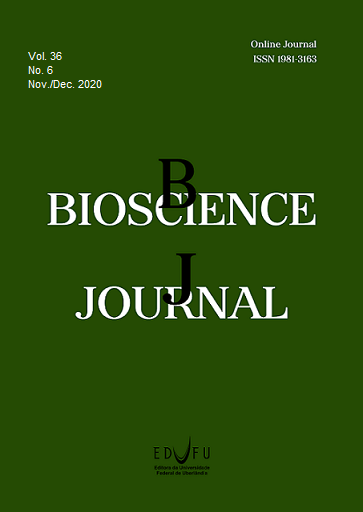Effectiveness of grape seed extract-based intracanal dressings against Enterococcus Faecalis and its influence on dentin microhardness and bond strength of filling material
DOI:
https://doi.org/10.14393/BJ-v36n6a2020-54066Keywords:
antimicrobial activity, bond strength, grape seed extract, intracanal dressing, microhardness.Abstract
The aim of this study was to evaluate the effectiveness of grape seed extract (GSE)-based intracanal dressings against Enterococcus faecalis (E. faecalis) and its influence on dentin microhardness and bond strength of the filling material. The root canals of 126 human teeth were distributed into three test groups: antimicrobial activity (60 teeth), dentin microhardness (30 teeth) and bond strength (36 teeth). In all three groups, specimens were subdivided into six groups, according to intracanal dressing protocols: G1 – distilled water (DW); G2 – 2% chlorhexidine gel (CHX); G3 – calcium hydroxide (Ca[OH]2)+DW; G4 – GSE+DW; G5 – Ca(OH)2+CHX; G6 – GSE+CHX. The counting of colony-forming units (CFUs), the Vickers microhardness tester and the push-out test were performed to evaluate the antimicrobial activity, dentin microhardness and bond strength, respectively. Specific statistical analysis was performed for each evaluation (α=5%). The greatest bacterial reduction was observed in G5 (Ca[OH]2+CHX) and G6 (GSE+CHX) (p<0.05). There was no statistically significant difference among groups in the dentin microhardness evaluation (p<0.05). The highest bond strength in the immediate evaluation was observed in G4 (GSE+DW) and G6 (GSE+CHX), whereas the highest bond strength after 12 months of storage was observed in G2 (CHX), G3 (Ca[OH]2+DW), G4 (GSE+DW), and G6 (GSE+CHX) (p<0.05). After the storage period, bond strength was increased in G2 (CHX) and G3 (Ca[OH]2+DW), and remained unchanged in G4 (GSE+DW) and G6 (GSE+CHX) (p<0.05). GSE-based intracanal dressings have antimicrobial potential against E. faecalis, have no influence in dentin microhardness and preserve the high bond strength of filling materials for root dentin over time.
Downloads
Published
Issue
Section
License
Copyright (c) 2020 Matheus Albino Souza, Daniel de Lima Dalla Lana, Amália Pletsch, Huriel Scartazzini Palhano, Juliane Bervian, João Paulo de Carli, Doglas Cecchin

This work is licensed under a Creative Commons Attribution 4.0 International License.





